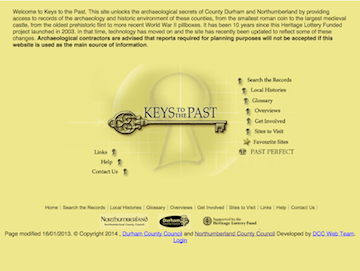Topics > Northumberland > Alwinton > Chew Green, Roman Fort
Chew Green, Roman Fort
Chew Green is the site of the ancient Roman encampment Ad Fines in Northumberland, England, north of Rochester and west of Alwinton. The encampment was adjacent to Dere Street, a Roman road that stretched south to York (Eboracum), and almost on the present-day border with Scotland.
Archaeological excavation at Chew Green has uncovered a complex of Roman military camps consisting of a Roman fort, two fortlets, two camps and a section of Roman road. The Roman remains were overlaid with evidence of a medieval settlement that included a small chapel. The largest camp structure is a square that encloses about with a defensive rampart and ditch. Evidence inside the fort indicates it was used as permanent settlement. Ad Fines likely served only as a military base, not a colonial settlement.
The site is within the Northumberland National Park and within the Military Training Area at Otterburn.
Visit the page: Chew Green for references and further details. You can contribute to this article on Wikipedia.

from Geograph (geograph)
Remains of Kemylpethe Chapel, Roman Fortlet, Chew Green
Pinned by Simon Cotterill

from http://www.keystothepast.info…
Chew Green (Alwinton)
- "There is a complex of Roman military camps at this remote location. A Roman fort, two fortlets, two camps and a section of Roman road can be seen here. Over …
Added by
Simon Cotterill

from https://historicengland.org.u…
Roman fort, two Roman fortlets, two Roman camps, a section of Roman road and a medieval settlement and chapel at Chew Green
- "The monument includes the remains of two temporary camps, two Roman fortlets, a Roman fort, a section of Dere Street and a deserted settlement and chapel of medieval date, situated …
Added by
Simon Cotterill

from http://www.pastscape.org.uk/h…
Chew Green
- "NT 70 NE 3 is now assigned parent status to individual child monuments NT 70 NE 27-31 (Camp I); (Fortlet II); (Camp III); (Fort IV) and (Fortlet V). The earthworks …
Added by
Simon Cotterill


from Geograph (geograph)
Remains of Kemylpethe Chapel, Roman Fortlet, Chew Green
Pinned by Simon Cotterill

from http://www.keystothepast.info…
Chew Green (Alwinton)
- "There is a complex of Roman military camps at this remote location. A Roman fort, two fortlets, two camps and a section of Roman road can be seen here. Over …
Added by
Simon Cotterill

from https://historicengland.org.u…
Roman fort, two Roman fortlets, two Roman camps, a section of Roman road and a medieval settlement and chapel at Chew Green
- "The monument includes the remains of two temporary camps, two Roman fortlets, a Roman fort, a section of Dere Street and a deserted settlement and chapel of medieval date, situated …
Added by
Simon Cotterill

from http://www.pastscape.org.uk/h…
Chew Green
- "NT 70 NE 3 is now assigned parent status to individual child monuments NT 70 NE 27-31 (Camp I); (Fortlet II); (Camp III); (Fort IV) and (Fortlet V). The earthworks …
Added by
Simon Cotterill













